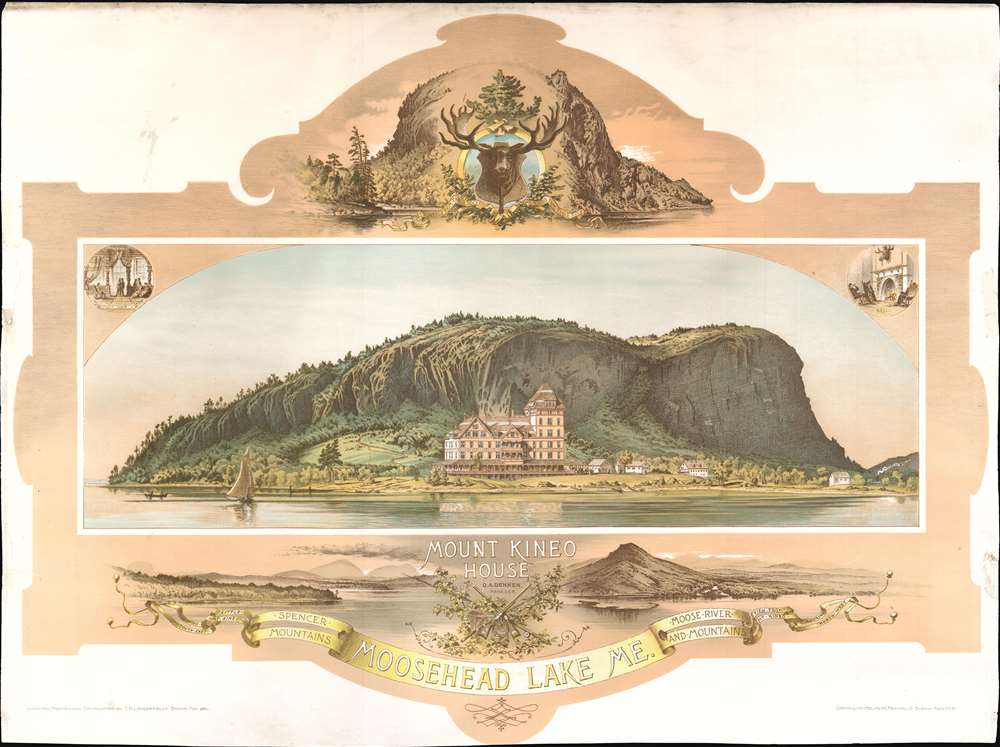This item has been sold, but you can get on the Waitlist to be notified if another example becomes available, or purchase a digital scan.
1886 Langerfeld View of Mount Kineo House, Moosehead Lake, Maine
MooseheadLake-langerfeldt-1886
Title
1886 (dated) 23.5 x 31.75 in (59.69 x 80.645 cm)
Description
Mount Kineo House
Mount Kineo House, as illustrated here, is the third lodge to occupy this location. The first Mt. Kineo House, built by Capt. Joshua Fogg in 1848, was a three and a half story tavern and inn with a wraparound veranda. It was destroyed by a fire in 1868. The Second Kineo House, a large five story inn with annex buildings, was opened in 1871 and itself destroyed by fire in 1882. The third house, illustrated here, opened in 1884. The present view, from 1886, was probably intended to celebrate the opening and promote the luxurious new property. The third Kineo House went through multiple upgrades and expansions, dramatically altering its footprint and turning it into a grand hotel by 1911. The building illustrated here predates most of these, but is described in a contemporary phamplet ,This hotel is planned on an ample scale and believed to be second to none in construction, general arrangement and convenience, as well as in its provision for the security and comfort of its guests. The dining room is 100 x 51 feet, seating four hundred people. Particular attention has been paid to the sanitary arrangements and drainage. The sleeping rooms are large, light, all provided with the best of mattresses and springs, and reached by broad stairways or steam elevator. Every room commands an excellent view of lake and mountain scenery. A piazza fifteen feet wide extends around the main house.Kineo House was ultimately demolished in 1938, when the property sold. Today it is the site of a golf course but some of the annex properties still exist.
Chromolithography
Chromolithography is a color lithographic technique developed in the mid-19th century. The process involved using multiple lithographic stones, one for each color, to yield a rich composite effect. Oftentimes, the process would start with a black basecoat upon which subsequent colors were layered. Some chromolithographs used 30 or more separate lithographic stones to achieve the desired effect. Chromolithograph color could also be effectively blended for even more dramatic results. The process became extremely popular in the late 19th and early 20th centuries, when it emerged as the dominate method of color printing. The vivid color chromolithography produced made it exceptionally effective for advertising and propaganda imagery.Publication History and Census
This view was drawn by Theodore Otto Langerfeldt, a well-known architectural and view artist based in Boston. Langerfeldt was considered to be expensive in his day, suggesting that the publisher, and likely the hotel, lavished money on this production. It was printed in chromolithogph in Boston by the Heliotype Printing Company. Examples are rare. We are aware of one at the University of Southern Maine Osher Library and another at the Boston Athenaeum. There is at least one other in private hands.CartographerS
Theodore Otto Langerfeldt (March 2, 1841 - September 7, 1906) was a German-American painter active in the second half of the 19th century. Langefeldt was born in Buckeburg, Schaumburg-Lippe, Germany. He studied architecture at the Hanover Polytechnic School before moving to London. He immigrated to the United States in 1868, settling in Boston. His paintings are primary watercolors and focused on architecture - one of which one a price at the 1876 Philadelphia Centennial Exposition. He also worked with several New England viewmakers, among them Ackermann, creating bird's-eye views of Boston and Mount Kineo (Maine). Langerfeldt, as a commercial artist, was considered expensive by his contemporaries, but was always in demand. More by this mapmaker...
The Heliotype Printing Company (1872 - c. 1900) was a printing company based in Boston. The company was promoted as 'artistic printers by the best photogelatine and photolithographic processes.' They were reorganized in 1885, adapting chromolithographic and photo reprographic techniques. They remained active until at least the 1930s. Their offices were located at 211 Tremont Street, Boston. Learn More...

